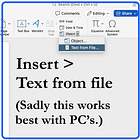✏️ Off topic student essays? Try this easy intervention.
Moving from off topic to focused takes less effort than you’d think!
Note: I thought my voiceover sounded weird at the end, but you can now listen regardless!
If you search how to help students stay on topic when writing, some interventions suggest outlining while others recommend restating the question. Yet the issue goes deeper. How can we help our students focus better when writing?
The Problem. Focused responses mean answering questions in the order asked. Otherwise, partial, incomplete, or irrelevant responses become off-topic. What does this look like?
Some students jump through the cracks while others announce they don't understand the question. For years, the following dialogue played out in my classroom essay after essay.
Student: (Raises hand.) What are we writing about?
Me: We're days into writing and we discussed the question days before that. Where's your paper?
Student: (Shrugs shoulders.) I don't know.
Me: Where's your folder?
Student: (Oblivious.) I don't have a folder.
Organization issues aside, something about my routines didn't stick. Looking in the mirror, I realized my introductions were passive. I talked; they snoozed. Many faked busy until they couldn't.
So how could I increase engagement and encourage more active participation from the start? The answer included both silence and discussion.
The Intervention. My solution had two parts: First, require prompts on desks at all times while writing. Second, embed active reading questions within the prompt, transforming introductions into discussions. (See below.)
Active Reading Questions
[__] 1. Write two questions about the assignment at the bottom of the page.
[__] 2. Annotate the topics with capital letters and write an outline in the margin.
[__] 3. What text structure does each prompt require?
[__] 4. What does the prompt ask you to do? Summarize it below as a command.
The Procedure. Unless students begin by discussing past responses, the procedure takes three main steps before they start any writing activity:
1. Students read and complete the active reading questions for 2-3 minutes.
2. Introductions begin with questions, addressing misconceptions and adding clarifications.
3. I read through the prompt and we practice creating a basic outline from the question.
The Results. Initially this procedure annoys students. They protest writing questions ("I don't have any") until they think of them. Let's not forget that ice cream tastes better than broccoli, and teenagers whine like exhaling. But the results were clear:
Student discussion drove the introduction. As with question writing activities, even if not every student speaks, every student thinks. Here, students drove the introduction, not me.
Students quit asking what they were writing. I can't state which single question or activity works best, but cumulatively they each helped.
Off topic responses decreased overnight. As the ultimate goal, responses became more focused. I still get incomplete or partial responses, but mainly from poor time management.
Aside: What exercise makes the best introduction? Students discussing student writing. Moving from student voices to student questions further drives down off topic responses. See my post "Three Big Benefits to Teaching with Student Writing.”
Try it! Feel free to steal these questions and experiment. These active reading questions connect well with other question writing activities. While I’d recommend keeping the routine itself, allowing students to lead with questions, the questions themselves have wiggle room.
✍️ Feel free to leave questions in the comment section!
New to the blog? Explore some other favorites!
✏️ Need a place to start? Check out my ongoing series, Teach Writing Tomorrow.
📓 Want other tips for teaching writing? Check out some fan favorites.
🏆 And here are some other popular posts:
🪩 BONUS! I just wanted to throw these here too…







Lots of great ideas - the students are lucky to have a reflective practitioner as their teacher!
I always make my students do all those types of "annoying" things to help them prep for their essay and they are working on assignments.
And they whine for the first couple months of school.
Somewhere around December they realize that doing their assignments actually helps them with the essay and the whining (somewhat) decreases. Getting to December is tough though!!